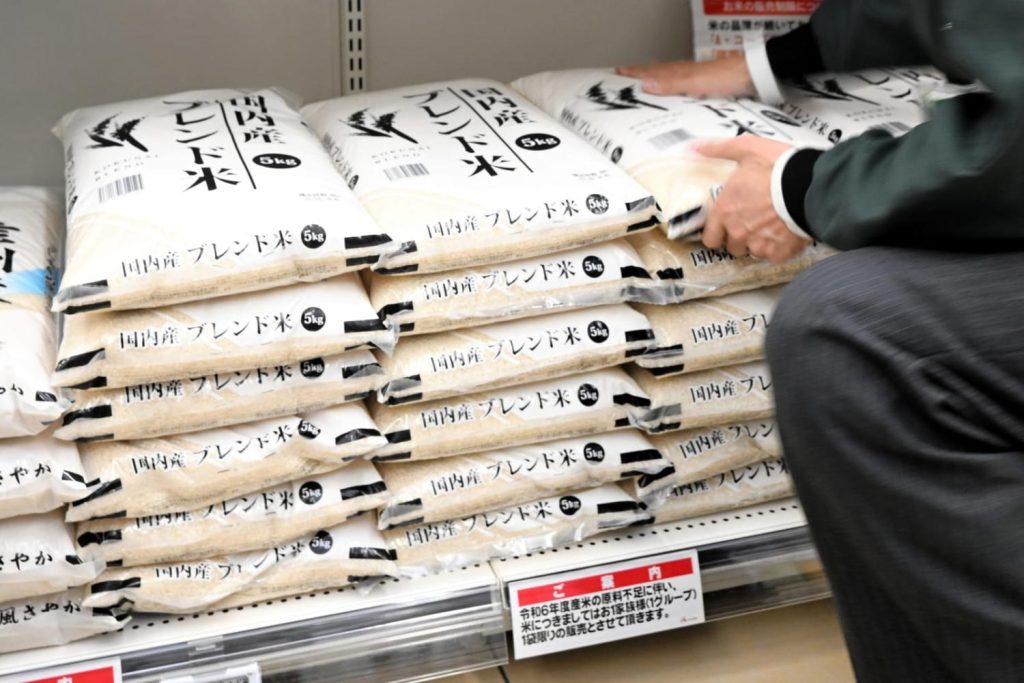Tags
Rice prices soar as Japanrethinks food security
Yusaku Yoshikawa.
Global instability, climate stress and small-scale
farming practices are all putting stress on the market.

Will the price fall? Japan has seen unprecedented increases in the cost of rice in recent months, affecting both consumers and the food industry. The surge is prompting the country to re-evaluate rice as a staple food in terms of food security and prepare for future uncertainties.
In May, the retail price of a five-kilogram bag of rice was ¥4,268 (US$29.90), compared to ¥2,228 (US$15.60) a year earlier. Assuming that a household consumes 20 kilograms of rice per month, this hike forces them to spend an extra ¥98,000 (US$687) in a year. And given that more than 30 per cent of households in Japan had an income of below ¥3 million (US$21,032) in 2022, the hike has significant consequences. Save the Children Japan has already reported that almost a third of low-income families surveyed were reducing rice consumption due to the cost.
Last week, the price crisis cost the agriculture minister his job, been seen as out of touch for saying he never buys rice because supporters give it to him for free.
The Ministry of Agriculture, Forestry and Fisheries (MAFF) has since March released stockpiled rice for emergency use in a bid to stabilise prices. However, this move has failed to curb the upwards trend because a limited amount made it to retailers.
Historically, Japan has sought since 1970 to reduce domestic rice production under a government initiative known as gentan. The policy was driven by a trend of steady decline in domestic rice consumption.
Japan must seek alternative channels to supplement domestic production.
But 2024 posed a special challenge. A heat wave the year prior reduced the quality and transaction volume of rice. Recent record-breaking heat increased stink bug damage. Then an earthquake warning in August prompted consumers to purchase extra rice for their stock. Rice demand was also boosted by a price advantage over wheat, the cost of which had also spiked due to unstable international supply stemming from Russia’s invasion of Ukraine. The price of fertilisers has risen by more than 30 per cent in five years mainly due to the Russia–Ukraine war.
Production structure is a further factor. Most rice farmers in Japan are small-scale. In 2024, almost two-thirds of rice farmers in Japan cultivated less than one hectare. Yet large-scale farmers are needed to sustain production. In 2020, for example, 16 per cent of rice farmers cultivated more than three hectares, accounting for 70 per cent of the total cultivated area. The number of farmers cultivating over 15 hectares increased by 83 per cent in a decade from 6,654 in 2010 to 12,194 in 2020.
Given these growing instabilities, the price increase is likely to recur. Without stable production, the rice shortages could become even more severe.

The Mitsubishi Research Institute (MRI) claims that the price increase calls for an overhaul of Japan’s rice policy. Climate change and other factors have made it increasingly difficult for the government to accurately predict domestic demand. Scaling up of rice farmers through farmland accumulation has begun to reach its limits. Creating economic advantages for rice is a key to overcome the situation, says MRI.
Nonetheless, rice, an almost self-sufficient crop in the country, will continue to play a vital role in ensuring the country’s food security. Japan’s food self-sufficiency rate stood at 38 per cent on a calorie basis in FY2023, and the rates were lower for other staple crops such as wheat (18 per cent) and soy beans (26 per cent). Rice production is likely to recover in the short term, as farmers aim to increase rice production this year with crops to hit the market in 2026. MAFF has also promised to review a production adjustment policy to increase rice production. However, the surge in production then carries a risk of a collapse in the farm-gate rice price.
In the long term, Japan must seek alternative channels to supplement domestic production providing for failure in stable rice supply. The government is considering increasing rice imports from the United States to address the market shortage, which may advantage Japan following the tariffs imposed by US President Donald Trump. But there are alternative sources and a staple crop should not be treated as a negotiating card. Thailand has a rice surplus after India recently lifted its rice export ban, causing the price to hit a three-year low. While domestic production should continue to be given the priority, these channels can help stabilise the prices in the country. Diversifying sources of imports as a buffer and balancing them with domestic production will help Japan to prepare for future rice shortages in the country.
Published Date: May 27, 2025






